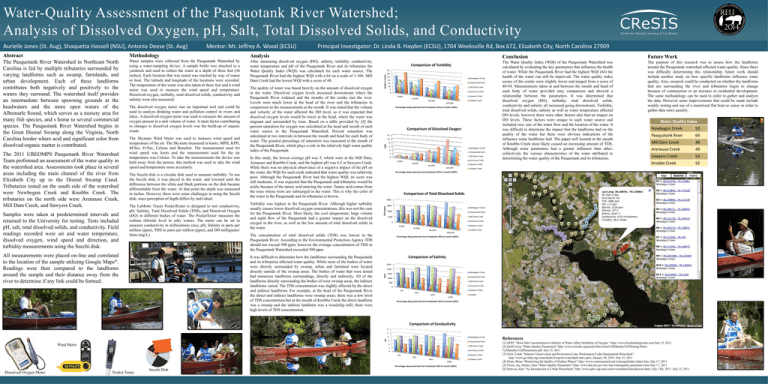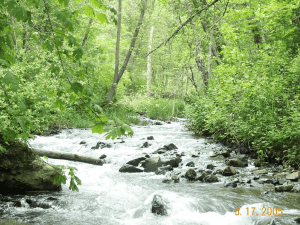Comparison of Total Dissolved Solids
advertisement

Water-Quality Assessment of the Pasquotank River Watershed; Analysis of Dissolved Oxygen, pH, Salt, Total Dissolved Solids, and Conductivity The 2011 UREOMPS Pasquotank River Watershed Team performed an assessment of the water quality in the watershed area. Assessments took place in several areas including the main channel of the river from Elizabeth City up to the Dismal Swamp Canal. Tributaries tested on the south side of the watershed were Newbegun Creek and Knobbs Creek. The tributaries on the north side were Areneuse Creek, Mill Dam Creek, and Sawyers Creek. Samples were taken at predetermined intervals and returned to the University for testing. Tests included pH, salt, total dissolved solids, and conductivity. Field readings recorded were air and water temperature, dissolved oxygen, wind speed and direction, and turbidity measurements using the Secchi disk. Principal Investigator: Dr. Linda B. Hayden (ECSU), 1704 Weeksville Rd, Box 672, Elizabeth City, North Carolina 27909 Water samples were collected from the Pasquotank Watershed by using a water-sampling device. A sample bottle was attached to a yardstick and used to collect the water at a depth of three feet (36 inches). Each location that was tested was reached by way of canoe or boat. The latitude and longitude of the locations were recorded. The temperature of the water was also taken at three feet and a wind meter was used to measure the wind speed and temperature. Dissolved oxygen, turbidity, total dissolved solids, conductivity and salinity were also measured. After measuring dissolved oxygen (DO), salinity, turbidity, conductivity, water temperature and pH of the Pasquotank River and its tributaries the Water Quality Index (WQI) was calculated for each water source. The Pasquotank River had the highest WQI with a 64 on a scale of 1-100. Mill Dam Creek had the lowest WQI with a score of 48. The dissolved oxygen meter was an important tool and could be used to analyze drinking water and pollution control in rivers and lakes. A dissolved oxygen meter was used to measure the amount of oxygen present in a unit volume of water. A main factor contributing to changes in dissolved oxygen levels was the build-up of organic waste. The Skymate Wind Meter was used to measure wind speed and temperature of the air. The Skymate measured in knots, MPH, KPH, M/Sec, Ft/Sec, Celsius and Beaufort. The measurement used for wind speed was knots and the measurement used for the air temperature was Celsius. To take the measurements the device was held away from the person, this method was used to take the wind speed and temperature more accurately. The Secchi disk is a circular disk used to measure turbidity. To use the Secchi disk, it was placed in the water, and lowered until the difference between the white and black portions on the disk became differentiable from the water. At that point the depth was measured in inches. However, there were some challenges in using the Secchi disk, since perception of depth differs by individual. The LaMotte Tracer PocketTester is designed to test conductivity, pH, Salinity, Total Dissolved Solids (TDS), and Dissolved Oxygen (DO) in different bodies of water. The PocketTester measures the sodium chloride level in salty waters. The meter can be set to measure conductivity in millisiemens (ms), pH, Salinity in parts per million (ppm), TDS in parts per million (ppm), and DO milligrams/ liters (mg/L). All measurements were placed on-line and correlated to the location of the sample utilizing Google Maps®. Readings were then compared to the landforms around the sample and their distance away from the river to determine if any link could be formed. The quality of water was based heavily on the amount of dissolved oxygen in the water. Dissolved oxygen levels increased downstream where the Pasquotank River widened and the mouths of the creeks met the river. Levels were much lower at the head of the river and the tributaries in comparison to the measurements at the mouth. It was stated that the volume and velocity of the water affected the DO level, so it was expected that dissolved oxygen levels would be lower at the head, where the water was stagnant and surrounded by trees. Based on a table provided by [4] the percent saturation for oxygen was calculated at the head and mouth of each water source in the Pasquotank Watershed. Percent saturation was calculated at two intervals in between the mouth and head for each body of water. The greatest percentage of saturation was measured at the mouth of the Pasquotank River, which plays a role in the relatively high water quality index of the Pasquotank. Comparison of Turbidity Depth in Inches Analysis 35 30 25 20 15 10 5 0 Newbegun Creek Pasquotank River Mill Dam Creek Areneuse Creek Sawyers Creek 0.00% 33.00% Knobbs Creek 66.00% 100.00% Percentage along waterway from headwater (0%) to mouth (100%) Comparison of Dissolved Oxygen 12 10 8 mg/L Methodology 6 Newbegun Creek 4 Pasquotank River 2 In this study, the lowest average pH was 5, which were at the Mill Dam, Areneuse and Knobbs Creek, and the highest pH was 6.5 at Sawyers Creek. While there was no physical observance of a negative impact of the pH on the water, the WQI for each creek indicated that water quality was relatively poor. Although the Pasquotank River had the highest WQI, its score was still moderate. It was expected that the Pasquotank and tributaries would be acidic because of the tannic acid entering the water. Tannic acid comes from the trees whose roots are submerged in the water. This is why the color of the water in the Pasquotank and its tributaries is brown. Mill Dam Creek 0 Areneuse Creek 0.00% 33.00% Conclusion Future Work The Water Quality Index (WQI) of the Pasquotank Watershed was calculated by evaluating the key parameters that influence the health of water. While the Pasquotank River had the highest WQI (64) the health of the water can still be improved. The water quality index scores of the creeks were slightly lower and ranged from a score of 48-54. Measurements taken at and between the mouth and head of each body of water provided easy comparison and showed a relationship between the parameters. It was determined that dissolved oxygen (DO), turbidity, total dissolved solids, conductivity and salinity all increased going downstream. Turbidity, total dissolved solids, salinity as well as water temperature affected DO levels, however there were other factors also had an impact on DO levels. These factors were unique to each water source and included size, rate of the water flow and the location of the water. It was difficult to determine the impact that the landforms had on the quality of the water but there were obvious indications of the influence some landforms had. The paper mill located at the mouth of Knobbs Creek most likely caused an increasing amount of TDS. Although some parameters had a greater influence than other; collectively the various characteristics of the water attributed to determining the water quality of the Pasquotank and its tributaries. The purpose of this research was to assess how the landforms around the Pasquotank watershed affected water quality. Since there was difficulty determining this relationship, future work should include another study on how specific landforms influence water quality. Also, research could be conducted on whether the landforms that are surrounding the river and tributaries begin to change because of construction or an increase in residential development. The same methodology can be used in order to gather and analyze the data. However some improvements that could be made include weekly testing and use of a motorized flat boat or canoe in order to gather data more quickly. Sawyers Creek 66.00% 100.00% Water Quality Index Newbegun Creek 50 Pasquotank River 64 Mill Dam Creek 48 Areneuse Creek 49 Sawyers Creek 54 Knobbs Creek 52 Knobbs Creek Percentage along waterway from headwater (0%) to mouth (100%) Comparison of Total Dissolved Solids 4000 Turbidity was highest in the Pasquotank River. Although higher turbidity usually causes lower dissolved oxygen concentrations, this was not the case for the Pasquotank River. Most likely, the cool temperature, large volume and rapid flow of the Pasquotank had a greater impact on the dissolved oxygen in the river, as well as the low amount of total dissolved solids in the water. TDS (ppm) Abstract The Pasquotank River Watershed in Northeast North Carolina is fed by multiple tributaries surrounded by varying landforms such as swamp, farmlands, and urban development. Each of these landforms contributes both negatively and positively to the waters they surround. The watershed itself provides an intermediate between spawning grounds at the headwaters and the more open waters of the Albemarle Sound, which serves as a nursery area for many fish species, and s home to several commercial species. The Pasquotank River Watershed begins in the Great Dismal Swamp along the Virginia, North Carolina border where acid and significant color from dissolved organic matter is contributed. Mentor: Mr. Jeffrey A. Wood (ECSU) 3000 Newbegun Creek 2000 Pasquotank River 1000 Mill Dam Creek 0.00% Sawyers Creek 33.00% Knobbs Creek 66.00% 100.00% The concentration of total dissolved solids (TDS) was lowest in the Pasquotank River. According to the Environmental Protection Agency TDS should not exceed 500 ppm; however the average concentration of TDS in the Pasquotank Watershed exceeded 500 ppm. It was difficult to determine how the landforms surrounding the Pasquotank and its tributaries affected water quality. While most of the bodies of water were directly surrounded by swamp, urban and farmland were located directly outside of the swamp areas. The bodies of water that were tested had numerous landforms surroundings, directly and indirectly. All of the landforms directly surrounding the bodies of were swamp areas, the indirect landforms varied. The TDS concentration was slightly affected by the direct and indirect landforms. For example, at the head of the Pasquotank River the direct and indirect landforms were swamp areas; there was a low level of TDS concentration but at the mouth of Knobbs Creek the direct landform was a swamp and the indirect landform was a woodchip mill; there were high levels of TDS concentration. Areneuse Creek 0 Percentage along waterway from headwater (0%) to mouth (100%) Comparison of Salinity 2500 2000 ppm Aurielle Jones (St. Aug), Shaquetta Hassell (NSU), Antonio Deese (St. Aug) Newbegun Creek 1500 Pasquotank River 1000 Mill Dam Creek 500 Areneuse Creek 0 0% Sawyers Creek 33% Knobbs 66% 100% Percentage along waterway from headwater (0%) to mouth (100%) Comparison of Conductivity 6 mS 5 Wind Meter 4 Newbegun Creek 3 Pasquotank River 2 Mill Dam Creek 1 Areneuse Creek 0 0% Sawyers Creek 33% 66% Knobbs Creek 100% Percentage along waterway from headwater (0%) to mouth (100%) Dissolved Oxygen Meter Pocket Tester Secchi Disk References [1] APEC “Does Salt Concentration or Salinity of Water Affect Solubility of Oxygen.” http://www.freedrinkingwater.com July 15, 2011 [2] Earth Force “Water Quality Parameters” http://www.eeweek.org/assets/files/water%20Quality%20Testing/Water %20Quality%20Parameters.pdf. July 15, 2011 [3] Grob, Linda “Salmon Conservation and Restoration Lake Washington/Cedar/Sammamish Watershed.” http://www.govlink.org/watersheds/8/reports/watershed-intro.apsx, January 28, 2010. July 15, 2011 [4] Oram, Brian “Monitoring the Quality of Surface Waters” http://www.waterresearch.net/waterqualindex/index.htm. July 17, 2011 [5] Nixon, Jay, Pauley, Sara “Water Quality Parameters” http://www.dnr.mo.gov/env/esp/waterquality-parameters.htm July 17, 2011 [6] Srinivas, Hari “An Introduction to Urban Watersheds” http://www.gdrc.org/uem/water/watershed/introduction.html. July 13th, 2011. July 15, 2011







